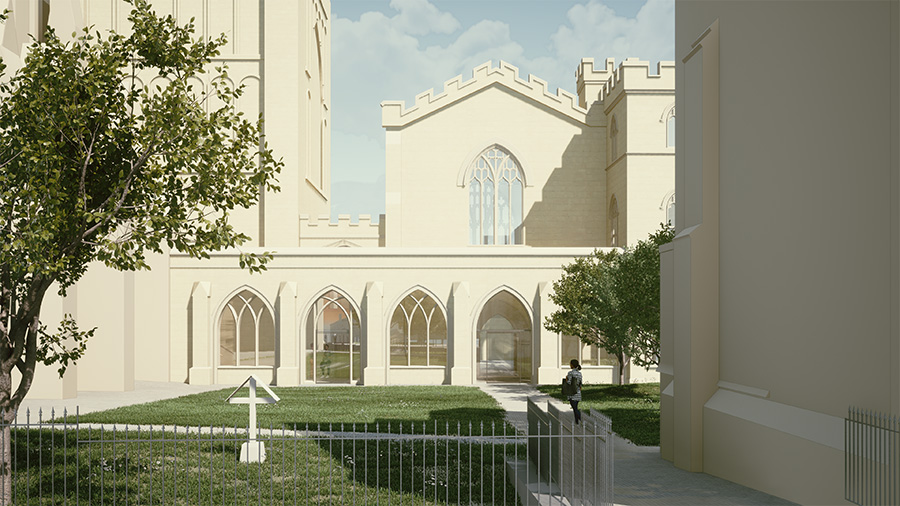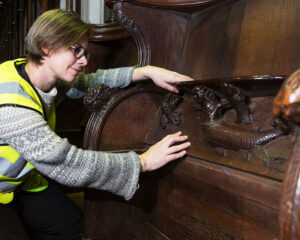
Exeter Cathedral’s most significant building project since 1887 began today in the first phase of an ambitious new development project.
Work began today [18 November] in the cathedral’s Cloister Garden, where a specialist building team are recreating a new Cloister Gallery. The new construction replaces original medieval cloisters, which were demolished in 1657, and recreates a covered walkway to connect the cathedral with its 13th century Chapter House and Pearson Building. It will be the first major construction to be added to the cathedral since the Pearson building was completed in the late 19th century. The most recent additions prior to the Pearson building are the cathedral’s Speke and Oldham chapels, built 500 years ago.
Other development works taking place in the Cloister Garden include the preparation of a Treasures Exhibition space which will safely showcase ancient collections from the cathedral’s library and archive. New toilet facilities with improved accessibility will also be installed as part of the project.
The first phase of the project is expected to take two years to complete, but for The Revd Canon Chris Palmer, Exeter Cathedral’s Canon Treasurer, who is overseeing the project, the benefits far outweigh the inevitable disruption:
“We are delighted to have reached the point of starting this exciting project. We know we are going to have to live with inconvenience for a while, but we are really looking forward to the day when our new facilities greatly improve the experience of all our visitors and worshippers.”

Further phases of the project would see approximately half of the Grade I listed heritage site conserved and refurbished. Works include conservation of the cathedral’s 50 medieval misericords (or ‘mercy seats’), a more sustainable heating zoning system, new visitor interpretation to explain the history of the cathedral, a new Cathedral Shop, and lifts to make the new facilities and visitor experience accessible for everyone.
The work is being funded by Exeter Cathedral’s 2020s Development Appeal which aims to raise £10 million. The funds will support essential improvements and a calendar of community activities and events designed make the ancient Devon landmark more inclusive, accessible and sustainable for the future.
As Jill Taylor, Director of Development at Exeter Cathedral, explains, the appeal has already attracted significant support:
“Over half of our £10 million target has already been secured, thanks to an incredible £4.3 million grant awarded earlier this year by The National Lottery Heritage Fund, and a further £1.9 million from some extremely generous grant-giving trusts, foundations, corporate and private donors.
“We have been overwhelmed by the level of support and affection for this unique Devon landmark. But of course, we still have another £3.8 million to go if we are to reach our goal of ensuring a truly sustainable future for Exeter Cathedral, for generations to come.”
One of the ways in which Exeter Cathedral is hoping to raise the remaining funds is through a new Adopt a Stone scheme. Private and corporate supporters are being invited to ‘adopt a stone’ in the new Cloister Gallery building, with donation options ranging from a single stone block, to an entire doorway.
For The Very Revd Jonathan Greener, Dean of Exeter, one of the most important aspects of the development project is for Exeter Cathedral to be used by a wider range of communities across Devon. He explains:
“We want to preserve this precious piece of Devon heritage for future generations, just as previous generations did for us. But we also need to ensure that it continues to inspire and meet the needs of all the people of Devon for the 21st century.
“By supporting our Development Appeal, donors will be helping us to reach and serve a wider audience. They will be funding essential conservation and improvements to our building. But they will also be enabling us to improve the way we tell our story, and supporting an exciting new programme of events and activities designed to inspire and connect all Devonians with their local heritage.”